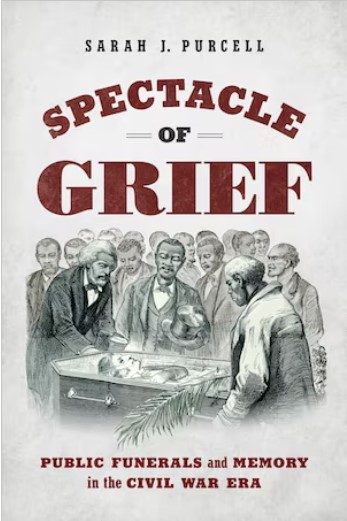Book Review: Spectacle of Grief: Public Funerals and Memory in the Civil War Era
The field of deathways studies is decidedly a niche market that many people find morbid, but there is no mistaking the fact that such work shines a light on American culture teaching us important things about ourselves – past and present. Author Sarah J. Percell’s new work, Spectacle of Grief: Public Funerals and Memory in the Civil War Era is a welcome addition to this field.
The L.F. Parker Professor of History at Grinnell College, Purcell is also known for her book Sealed With Blood: War, Sacrifice, and Memory in Revolutionary America (University of Pennsylvania Press, 2002) and a variety of textbooks which she authored or co-authored.
As she states in her introduction, “Public funerals, as cultural practices of collective mourning, helped to define American national identities in the second half of the nineteenth century, and they provide a lens for examining anew debates over competing strands of Civil War memory”(3) – which is contested ground indeed. Factions of all sorts competed to advance a narrative in the post-war world which favored their interpretation of the meaning of that deadly conflict. It is no surprise that Victorians, who were fascinated with death in general, would use public funerals for this purpose – whether it be to advocate for a reconciliation with the South or perhaps to push the Lost Cause myth.
Using prominent public funeral rites as case studies, Purcell examines “The Death of Compromise” using Henry Clay’s passing, “The Death of Union and the Martyrdom of Elmer Ellsworth and Stonewall Jackson,” the “Boundaries of Reconciliation” with George Peabody and Robert E. Lee, “Mourning, Memory, and Forgetting” with Charles Sumner and Joseph E. Johnston, and finally “Extraordinary Demonstrations of Respect” through the deaths of Frederick Douglass and Winnie Davis.
While I found the whole book utterly fascinating and very compelling, I was most interested in her look at the death and memory of Robert E. Lee in light of recent events which witnessed the dismantling of Confederate statues and memorials in Richmond, Virginia and beyond. Without a doubt, the Lost Cause is finally breathing its last. But, of course, with Lee’s death in 1870, “Mourning for Robert E. Lee,” as Purcell explains, “provided a major platform for the Lost Cause mythology that would dominate Southern culture for many decades to come, but it also showed how Southern Lost Cause memory sometimes intertwined with U.S. national identity in unexpected ways.” (118)
It is no secret that the Lost Cause mythos that began to be created even before Lee’s death did not only dominate the Southern memory of the war – but became pervasive in much of the North as well. Lee’s death and funeral played a central role in this. “Mourning for Robert E. Lee in the North and South showed that both the idea of reuniting the nation around the sorrowful memory of the dead Confederate hero and, even, the larger cult of Southern honor-in-loss made up part of the national fabric,” (119) Purcell argued persuasively.
Praise for Robert E. Lee in the days after his passing came as much from the North as from the South. Indeed, “Northerners were surprisingly willing to praise him as a Christian gentleman, a stoic defeated hero, and even a military leader.” (121) Of course, this did not sit well with everyone. Frederick Douglass was offended by the praise. “We can scarcely take up a newspaper…that is not filled with nauseating flatteries of the late Robert E. Lee,” (121) he complained.
In recognizing Lee in positive, even endearing terms, many in the North thought that such generosity demonstrated magnanimity they could well afford. Undoubtedly, as Purcell points out, the funerary rites and memory of “the general amply demonstrated the postwar public culture contained deep contradictions, even as it often imagined unity.” (139)
Purcell’s work is deeply researched, well written and compelling. The people and their funerals that she chose worked well for her purposes – though I have to admit I would have liked her take on Jefferson’s Davis’s funeral in 1889. Also, as a scholar of Victorian deathways, I would have liked a bit more context around Victorian notions of death and their constructed ways of observing it. In the late 19th century, the new consumer death fueled by the consumer revolution created opportunities and limitations that would have been helpful to illustrate. Still, Purcell’s work is excellent and it is valuable for understanding culture and memory in America at the time. I hope she pursues the work further.
Spectacle of Grief: Public Funerals and Memory in the Civil War Era
By Sarah J. Purcell
University of North Carolina Press, 2022, $34.95 Paperback
Reviewed by Derek D. Maxfield


Derek, what a great review — thanks for sharing your thoughts on the book!